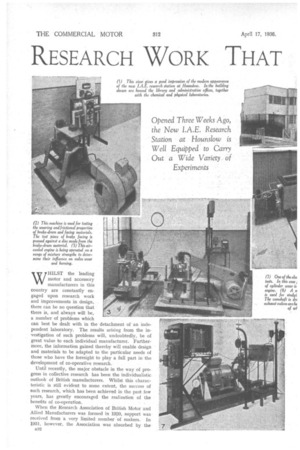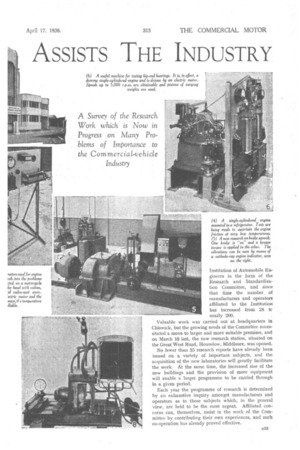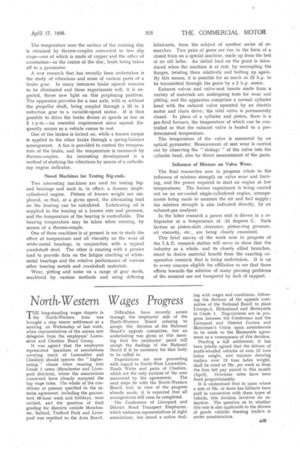RESEARCH WORK THAT ASSISTS THE INDUSTRY
Page 46

Page 47

Page 48

Page 49

If you've noticed an error in this article please click here to report it so we can fix it.
WHILST the leading motor and accessory manufacturers in this country are constantly engaged upon research work
and improvements in design, there can be no question that
there is, and always will be, L3 a number of problems which
can best be dealt with in the detachment of an independent laboratory. The results arising from the investigation of such problems will, undoubtedly, be of great value to each individual manufacturer. Furthermore, the information gained thereby will enable design and materials to be adapted to the particular needs of those who have the foresight to play a full part in the development of co-operative research.
Until recently, the major obstacle in the way of progress in collective research has been the individualistic outlook of British manufacturers. Whilst this characteristic is still evident to some extent, the success of such research, which has been achieved in the past few years, has greatly encouraged the realization of the benefits of co-operation.
When the Research Association of British Motor and Allied Manufacturers was formed in 1920, support was received from a very limited number of makers. In 1931, however, the Association was absorbed by the Institution of Automobile Engineers in the form of the Research and Standardization Committee, and since that time the number of manufacturers and operators affiliated to the Institution has increased from 28 tc nearly 200.
Valuable work was carried out at headquarters in Chiswick, but the growing needs of the Committee necessitated a move to larger and more suitable premises, and on March 18 last, the new research station, situated on the Great West Road, Hounslow, Middlesex, was opened.
No fewer than 35 research reports have already been issued on a variety of important subjects, and the acquisition of the new laboratories will greatly facilitate the work. At the same time, the increased size of the new buildings and the provision of more equipment will enable a larger programme to be carried through in a given period.
Each year the programme of research is determined by an exhaustive inquiry amongst manufacturers and operators as to those subjects which, in the general view, are held to be the most urgent. Affiliated concerns can themselves, assist in the work of the Committee by contributing their own experiences, and such co-operation has already proved effective. A useful branch of the research department is the abstraction and classification of important technical matter from over 100 British and foreign publications. These abstracts are circulated in loose-leaf form to affiliated members, who are thus enabled to acquire a mine of information without the expense of purchasing and examining the original publications. A total of 1,750 of these abstracts has already been issued, covering nearly 200 .subjects. Should a member wish to consult an original article, it is available on loan, free of charge.
Well-stocked Reference Library Available.
In addition to this service, a well-stocked library is provided at the laboratories. This contains a wide collection of reference books on automobile engineering and allied subjects, all of which are available for the use of members.
• The new research station was briefly described in the issue of The Commercial Motor dated March 20 last, and it includes well-equipped chemical and physical. laboratories. The latter is equipped with a 5-ton Buckton testing machine fitted with autographic equipment, a Vickers pyramid diamond hardness machine, an Avery rotating-bar fatigue machine, a Vickers projection microscope and sundry other apparatus. Adjoining, this laboratory is a photo
graphic dark room, which is notable for a labyrinth entrance, eliminating the need for doors.
The chassis test house is equipped with Heenan and Froude dynamometers suitable for commercial vehicles, private cars and motorcycles. Direct measurements of tractive effort can be made, the vehicle on test being connected to a drawbar, which is coupled to a torque arm. A pit is• also provided.
Next door to the chassis test house is the engine laboratory, containing eight test beds, four of which are equipped with electric dynamometers and four with hydraulic dynamometers. The usual arrangements are available for measurements of fuel, oil, etc.
The measuring room, which is thermostatically controlled to a constant temperature, is equipped with a number of gauges, reading to 0.0001 in., and a pneumatic gauge which reads to less than 0.00001 in. The latter instrument is so accurate that the pressure of finger and thumb on the outside of a cylinder can induce sufficient distortion to be recorded on the scale.
In the second block of buildings is situated the general laboratory, which is used for any mechanical testing or research other than engine research. The equipment in this laboratory naturally varies according to the nature of the programnie of research, and several of the interesting machines at present in use are described later in this article. The ceiling of the general laboratory is covered with sound-absorbing material, and, in a further bay that is available, if required, two under a34 ground compartments are provided. These may be used for storage purposes, or for experiments in which the amount of noise is excessive, or when it is desired to maintain a uniform temperature.
The research station is completed by a workshop and stores, administrative offices, and the resident caretakers quarters.
Several research reports on cylinder wear have already been issued by the I.A.E., and this important subject continues to receive careful attention ; six further researches are in progress. These include an investigation into the effects of the previous mileage of lubricating oil, and of contamination with ash and other foreign matter.
In these tests, samples of oil taken from the sumps of bus and car engines after long periods in service are used in the engine on test, and the conditions of runing are continuous operation at a medium load and
speed. The rate of cylinder, wear, with samples of filtrated oil, is also being _determined.
Various cylinder-liner materials are being tested as regards corrosion resistance under cold running conditions, and for general performance under intermittent operation. At the same time, a series of experi ments is to be made on the effect of various initial cylinder-bore finishes on the wear of a new engine which is being run-in. An air-cooled engine is in use for a study of the effect of oil viscosity or grade on cylinder wear at high wall temperatures, and a further experiment concerns the effect of certain upper-cylinder lubricants on the rate of wear.
The problem of the cold start has already engaged much attention and the latest research. work concerns the effect of width of ,piston rings on cylinder wear. The conditions of operation involve a start from cold every half-hour, followed by 15 minutes' running, part of which is under power.
Experiments on Brake Materials.
A good deal of research has been carried out on the frictional and wearing properties of brake-drum and brake-facing materials. The brake-facing to be tested is attached to a lever on the machine and pressed against a rotating disc made of the brake-drum material. The pressure is applied through a spring-balance, and the disc rotated by a dynamometer of the " swinging-field " type. In view of the importance of maintaining a constant rate of power dissipation, arrangements are made for the automatic adjustment of the pressure on the brake-facing to allow for changes in the coefficient of friction.
The temperature near the surface of the rotating disc is obtained by thermo-couples connected to two slip rings—one of which is made of copper and the other of constantan—in the centre of the disc, leads being taken off to a pyrometer.
A new research that has recently been undertaken is the study of vibrations and noise of various parts of a brake gear. In many instances brake squeak remains to be eliminated and these experiments will, it is expected, throw new light on this perplexing problem. The apparatus provides for a rear axle, with or without the propeller shaft, being coupled through a 20 to 1 reduction gear to a variable-speed motor. It is thus possible to drive the brake drums at speeds as low as 5 r.p.rn.—an essential requirement since squeak frequently occurs as a vehicle comes to rest.
One of the brakes is locked on, while a known torque is applied to the other brake through a spring-balance arrangement. A fan is provided to control the temperature of the brake, and the temperature is measured by thermo-couples. An interesting development is a method of studying the vibrations by means of a cathoderay engine indicator.
Novel Machines for Testing Big-ends.
Two interesting machines are used for testing bigend bearings and each is. in effect, a dummy singlecylindered engine. Pistons of known weight are employed, so that, at a given speed, the alternating load on the bearing can be calculated. Lubricating oil is supplied to the bearing at a known rate and pressure, and the temperature of the bearing is controllable. The bearing temperature may be taken when running, by means of a thermo-couple.
One of these machines is at present in use to study the effect of temperature and oil viscosity on the wear of white-metal bearings, in conjunction with a typical crankshaft steel. The other is running with a greater load to provide data on the. fatigue cracking of whitemetal bearings and the relative performance of 'various other bearing metals and crankshaft materials.
Wear, pitting and noise on a range of gear steels, machined by various methods and using differing lubricants, form the subject of another series of researches. Two pairs of gears are run in the form of a closed train on a special machine, made up from the bed of an old lathe. An initial load on the gears is introduced when the machine is at rest, by uncoupling the flanges, twisting them relatively and bolting up again. By this means, it is possible for as much as 53 h.p. to be transmitted through the gears by a 2 h.p. motor.
Exhaust valves and valve-seat inserts made from a variety of materials are undergoing tests for wear and pitting, and the apparatus comprises a normal cylinder head with the exhaust valve operated by an electric motor and chain drive ; the inlet valve is permanently closed. In place of a cylinder and piston, there is a gas-fired furnace, the temperature of which can be controlled so that the exhaust valve is heated to a predetermined temperature.
The temperature of the valve is measured by an optical pyrometer. Measurement of seat wear is carried out by observing the " sinkage " of the valve into the cylinder head, also by direct measurement of the parts.
Influence of Mixture on Valve Wear.
The final researches now in progress relate to the influence of mixture strength on valve wear and burning, and the power required to start an engine at low temperatures. The former experiment is being carried out on an air-cooled single-cylindered engine, arrangements being made to measure the air and fuel supply ; the mixture strength is also indicated directly, by an exhaust-gas analyser.
In the latter research a power unit is driven in a refrigerator at a temperature of -10 degrees C. Such factors as piston-skirt clearance, piston-ring pressure, oil viscosity, etc., are being closely examined.
This brief survey of the work now in progress at the I.A.E. research station will serve to show that the industry as a whole, and its closely allied branches, stand to derive material benefit from the exacting cooperative research that is being undertaken. It is up to every concern eligible for affiliation to see that these efforts towards the solution of many pressing problems of the moment are not hampered by lack of support.






























































































